wheel MERCEDES-BENZ METRIS 2016 MY16 Operator’s Manual
[x] Cancel search | Manufacturer: MERCEDES-BENZ, Model Year: 2016, Model line: METRIS, Model: MERCEDES-BENZ METRIS 2016Pages: 310, PDF Size: 7.28 MB
Page 85 of 310
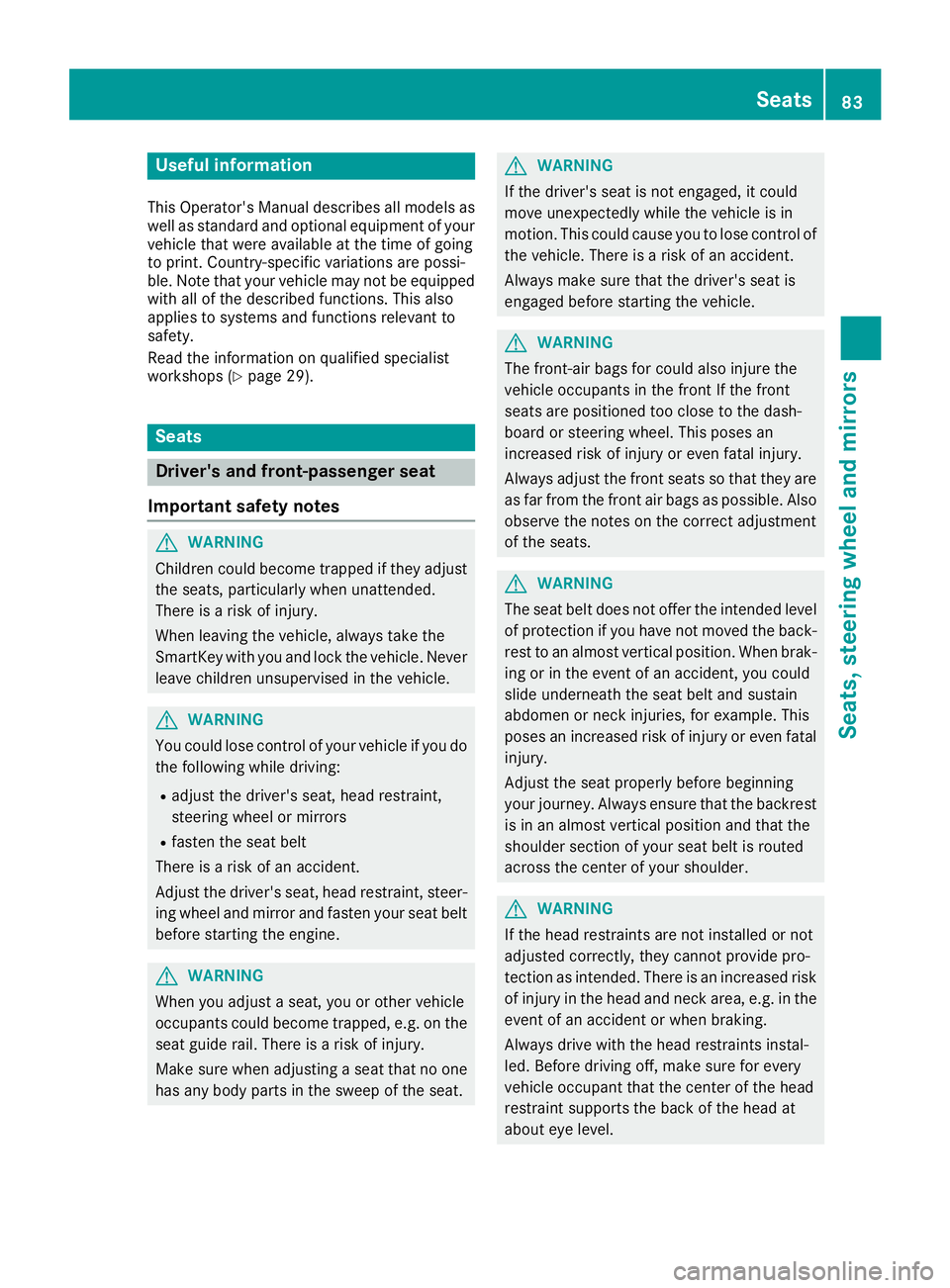
Useful information
This Operator's Manual describes all models as
well as standard and optional equipment of your
vehicle that were available at the time of going
to print.Country-specific variation sare possi-
ble. Note that your vehicle may not be equipped
with all of the described functions. This also
applies to system sand function srelevantt o
safety.
Read the information on qualified specialist
workshops (
Ypage 29).
Seats
Driver' sand front-passenger seat
Important safetyn otes
GWARNING
Children could become trapped if they adjust
the seats, particularly when unattended.
There is arisk of injury.
When leaving the vehicle, always tak ethe
SmartKey with you and lock the vehicle. Never
leave children unsupervised in the vehicle.
GWARNING
You could lose contro lofyour vehicle if you do
the following while driving:
Radjust the driver'ss eat, head restraint,
steering wheel or mirrors
Rfaste nthe seat belt
There is arisk of an accident.
Adjust the driver'ss eat, head restraint,steer-
ing wheel and mirrora nd fastenyour seat belt
before starting the engine.
GWARNING
When you adjust aseat, you or other vehicle
occupants could become trapped, e.g. on the seat guide rail. There is arisk of injury.
Make sure when adjusting aseat that no one
has any body parts in the sweep of the seat.
GWARNING
If the driver'ss eat is not engaged, it could
move unexpectedly while the vehicle is in
motion. This could cause you to lose contro lof
the vehicle. There is arisk of an accident.
Always make sure that the driver'ss eat is
engaged before starting the vehicle.
GWARNING
The front-air bags for could also injure the
vehicle occupants in the frontIft he front
seats are positioned too close to the dash-
board or steering wheel. This poses an
increased risk of injury or even fatal injury.
Always adjust the fronts eats so that they are
as far from the fronta ir bags as possible. Also
observet he notes on the correct adjustment
of the seats.
GWARNING
The seat belt does not offer the intended level of protection if you have not moved the back-
rest to an almost vertical position .When brak-
ing or in the eventofana ccident, you could
slide underneath the seat belt and sustain
abdomen or nec kinjuries, for example. This
poses an increased risk of injury or even fatal injury.
Adjust the seat properly before beginning
your journey. Always ensure that the backrest
is in an almost vertical position and that the
shoulder section of your seat belt is routed
across the center of your shoulder.
GWARNING
If the head restraint sare not installed or not
adjusted correctly, they cannot provide pro-
tection as intended. There is an increased risk
of injury in the head and nec karea, e.g. in the
eventofana ccidentorwhen braking.
Always drive with the head restraint sinstal-
led. Befored rivingoff, make sure for every
vehicle occupant that the center of the head
restraint supportst he back of the head at
about eye level.
Seats83
Seats, steering wheel and mirrors
Z
Page 86 of 310
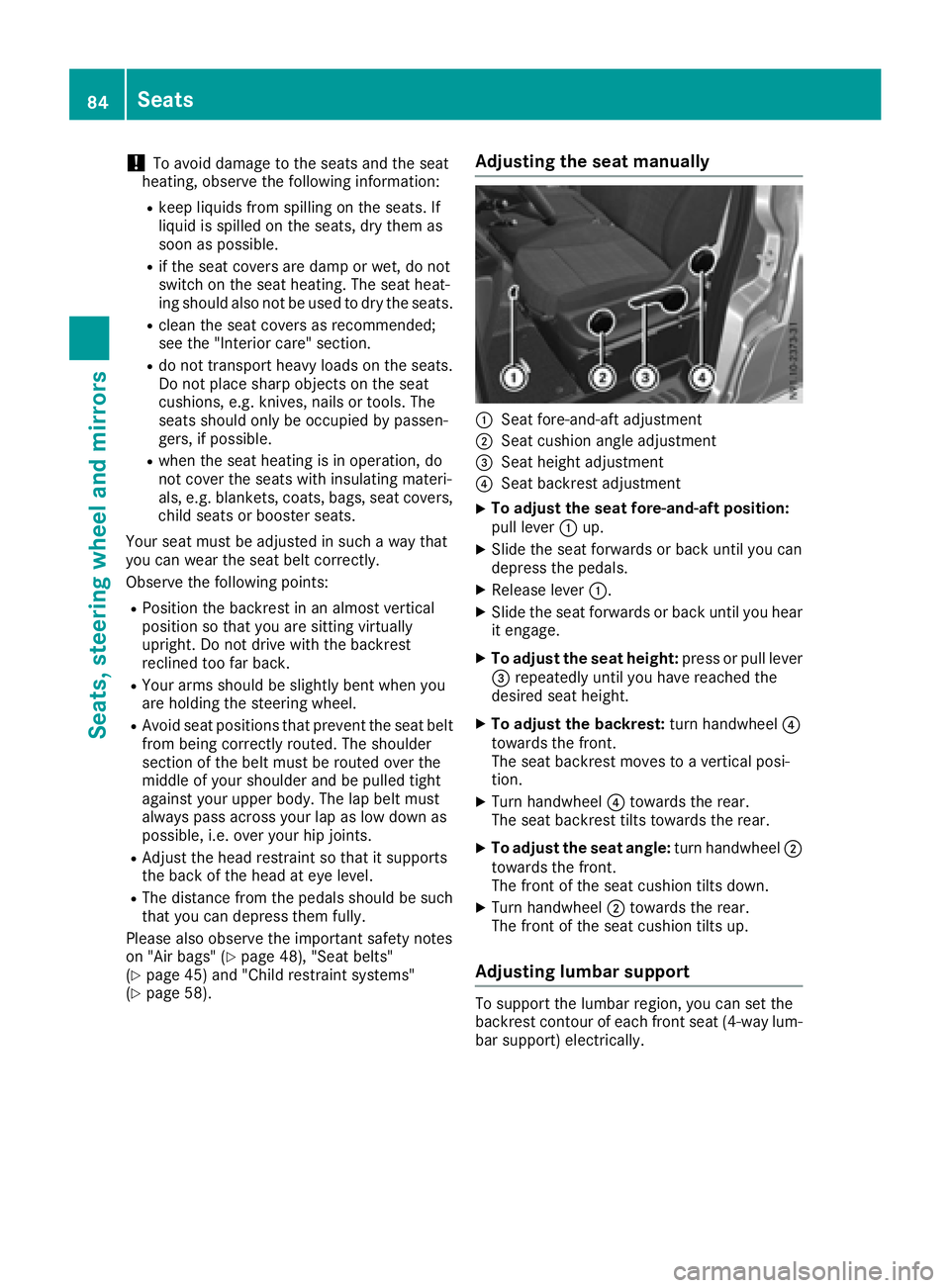
!To avoid damage to the seats and the seat
heating, observe the following information:
Rkeep liquids from spilling on the seats. If
liquid is spilledont he seats, dry them as
soon as possible.
Rif the seat covers are damp or wet, do not
switch on the seat heating. The seat heat-
ing should also not be used to dry the seats.
Rclean the seat covers as recommended;
see the "Interior care" section.
Rdo not transport heavy loads on the seats.
Do not place sharp objects on the seat
cushions, e.g. knives, nails or tools. The
seats should only be occupied by passen-
gers, if possible.
Rwhen the seat heating is in operation, do
not cover the seats with insulating materi-
als, e.g. blankets, coats, bags, seat covers,
child seats or booster seats.
Your seat must be adjusted in such away that
you can wear the seat belt correctly.
Observe the following points:
RPosition the backrest in an almost vertical
position so that you are sitting virtually
upright. Do not drive with the backrest
reclined too far back.
RYour arms should be slightly bent when you
are holding the steering wheel.
RAvoid seat positions that prevent the seat belt
from being correctly routed. The shoulder
section of the belt must be routed over the
middle of your shouldera nd be pulled tight
against your upper body. The lap belt must
always pass across your lap as low down as
possible,i .e. over your hip joints.
RAdjust the head restraint so that it supports
the back of the head at eye level.
RThe distance from the pedalss hould be such
that you can depress them fully.
Please also observe the important safety notes
on "Air bags" (
Ypage 48), "Seat belts"
(Ypage 45) and "Child restraint systems"
(Ypage 58).
Adjusting the seat manually
:Seat fore-and-aft adjustment
;Seat cushion angle adjustment
=Seat height adjustment
?Seat backrest adjustment
XTo adjust the seat fore-and-aft position:
pull lever :up.
XSlide the seat forwards or back until you can
depress the pedals.
XRelease lever :.
XSlide the seat forwards or back until you hear
it engage.
XTo adjust the seat height: press or pull lever
= repeatedly until you have reached the
desired seat height.
XTo adjust the backrest: turn handwheel?
towards the front.
The seat backrest moves to avertical posi-
tion.
XTurn handwheel ?towards the rear.
The seat backrest tilts towards the rear.
XTo adjust the seat angle: turn handwheel;
towards the front.
The front of the seat cushion tilts down.
XTurn handwheel ;towards the rear.
The front of the seat cushion tilts up.
Adjusting lumbar support
To support the lumbarr egion, you can set the
backrest contour of each front seat (4-way lum-
bar support) electrically.
84Seats
Seats, steering whee land mirrors
Page 87 of 310
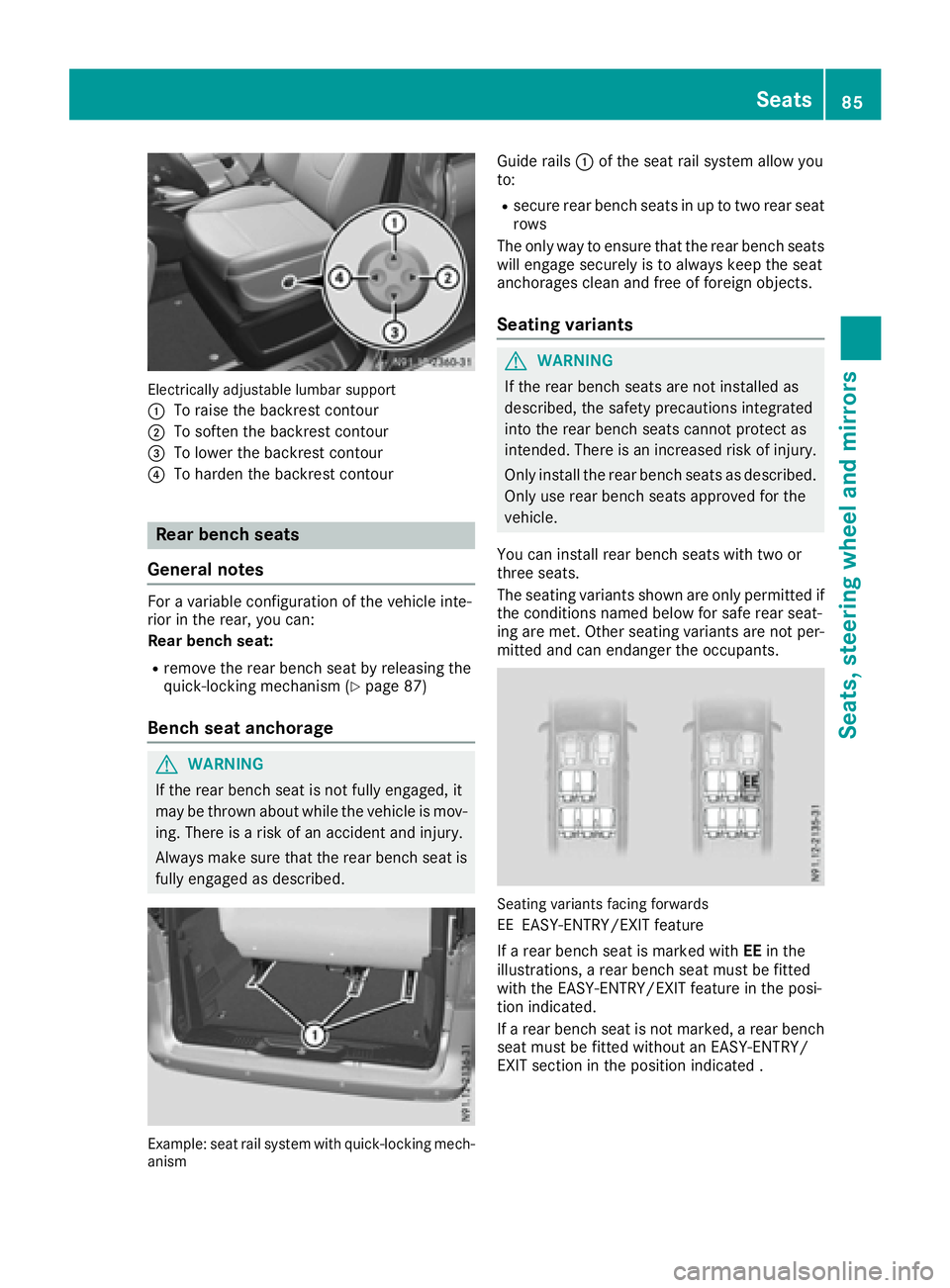
Electrically adjustable lumbarsuppo rt
:
To rais ethe backres tcontour
;To soften the backres tcontour
=To lowe rthe backres tcontour
?To harde nthe backres tcontour
Rear benchs eats
General notes
For avariabl econfiguratio nofthe vehicl einte-
rio rint he rear, yo ucan:
Rea rbench seat:
Rremove the rea rbench sea tbyreleasing the
quick-locking mechanism (Ypage 87)
Bench seat anchorage
GWARNING
If the rea rbench sea tisn ot full yengaged ,it
maybet hrown aboutw hilethe vehicl eismov-
ing .There is ariskofana ccident and injury.
Alway smakes uret hatt he rea rbench sea tis
full yengaged as described.
Example: sea trails ys tem with quick-locking mech-
anism
Guid erails :of the sea trails ystem allo wyou
to:
Rsecur erearb ench seats in up to two rea rseat
rows
The onl ywayto ensure thatt he rearbench seats
will engag esecurel yistoa lwayskeept he seat
anchoragesc lean and freeoff oreignobjects.
Seatin gvariants
GWARNING
If the rea rbench seats ar enot installe das
described, the safety precautions integrated
into the rea rbench seats canno tprotect as
intended. There is an increased ris kofinjury.
Onlyi nstallthe rea rbench seats as described.
Onlyu serea rbench seats approved for the
vehicle.
Yo uc an instal lrea rb ench seats with two or
threes eats.
The seating variants shown ar eonlyp ermitted if
the conditions named belo wfor safe rea rseat-
ing ar emet. Othe rseating variants ar enot per-
mitte dand can endanger the occupants.
Seating variants facing forwards
EE
EASY-ENTRY/EXIT feature
If ar earb ench sea tism arked with EEin the
illustrations, arearb ench sea tmustbef itted
with the EASY-ENTRY/EXIT featur einthe posi-
tio nindicated.
If ar earb ench sea tisn ot marked ,arearb ench
sea tmustbef ittedw ithou tanE ASY-ENTRY/
EXIT sectio ninthe positio nindicated .
Seats85
Seats, steering wheel andmirrors
Z
Page 88 of 310
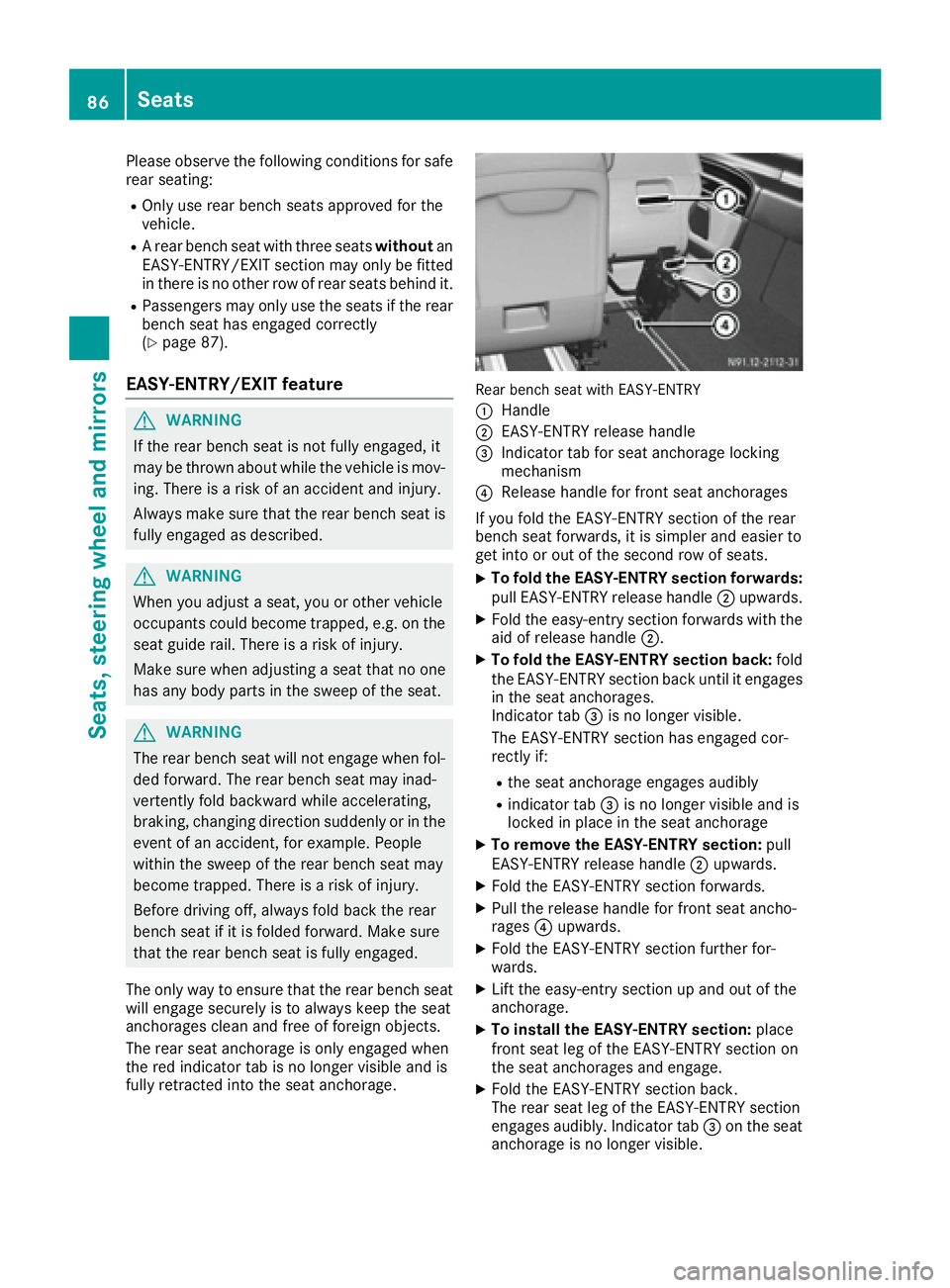
Please observe the following conditions for safe
rear seating:
ROnly use rear bench seats approved for the
vehicle.
RArear bench seat with three seats withoutan
EASY-ENTRY/EXIT section may only be fitted
in there is no other row of rear seats behind it.
RPassengers may only use the seats if the rear
bench seat has engaged correctly
(
Ypage 87).
EASY-ENTRY/EXIT feature
GWARNING
If the rear bench seat is not fully engaged, it
may be thrown about while the vehicle is mov-
ing. There is arisk of an accident and injury.
Always make sure that the rear bench seat is
fully engaged as described.
GWARNING
When you adjust aseat, you or other vehicle
occupantsc ould become trapped, e.g. on the
seat guide rail. There is arisk of injury.
Make sure when adjusting aseat that no one
has any body parts in the sweep of the seat.
GWARNING
The rear bench seat will not engage when fol-
ded forward. The rear bench seat may inad-
vertently fold backward while accelerating,
braking, changin gdirection suddenly or in the
event of an accident ,for example. People
within the sweep of the rear bench seat may
become trapped. There is arisk of injury.
Before driving off, alwaysf old back the rear
bench seat if it is folded forward. Make sure
that the rear bench seat is fully engaged.
The only way to ensure that the rear bench seat
will engage securely is to alwaysk eep the seat
anchorages clean and free of foreign objects.
The rear seat anchorage is only engaged when
the red indicator tab is no longer visible and is
fully retracted into the seat anchorage.
Rear bench seat with EASY-ENTRY
:
Handle
;EASY-ENTRY release handle
=Indicator tab for seat anchorage locking
mechanism
?Release handle for fronts eat anchorages
If you fold the EASY-ENTRY section of the rear
bench seat forwards, it is simpler and easier to
get into or out of the second row of seats.
XTo fold the EASY-ENTRY section forwards:
pull EASY-ENTRY release handle ;upwards.
XFold the easy-entr ysection forwards with the
aid of release handle ;.
XTo fold the EASY-ENTRY section back: fold
the EASY-ENTRY section back until it engages
in the seat anchorages.
Indicator tab =is no longer visible.
The EASY-ENTRY section has engaged cor-
rectly if:
Rthe seat anchorage engages audibly
Rindicator tab =is no longer visible and is
locked in place in the seat anchorage
XTo remove the EASY-ENTRY section: pull
EASY-ENTRY release handle ;upwards.
XFold the EASY-ENTRY section forwards.
XPull the release handle for fronts eat ancho-
rages ?upwards.
XFold the EASY-ENTRY section further for-
wards.
XLift the easy-entr ysection up and out of the
anchorage.
XTo install the EASY-ENTRY section: place
fronts eat leg of the EASY-ENTRY section on
the seat anchorages and engage.
XFold the EASY-ENTRY section back.
The rear seat leg of the EASY-ENTRY section
engages audibly.I ndicator tab=on the seat
anchorage is no longer visible.
86Seats
Seats, steering wheel and mirrors
Page 89 of 310
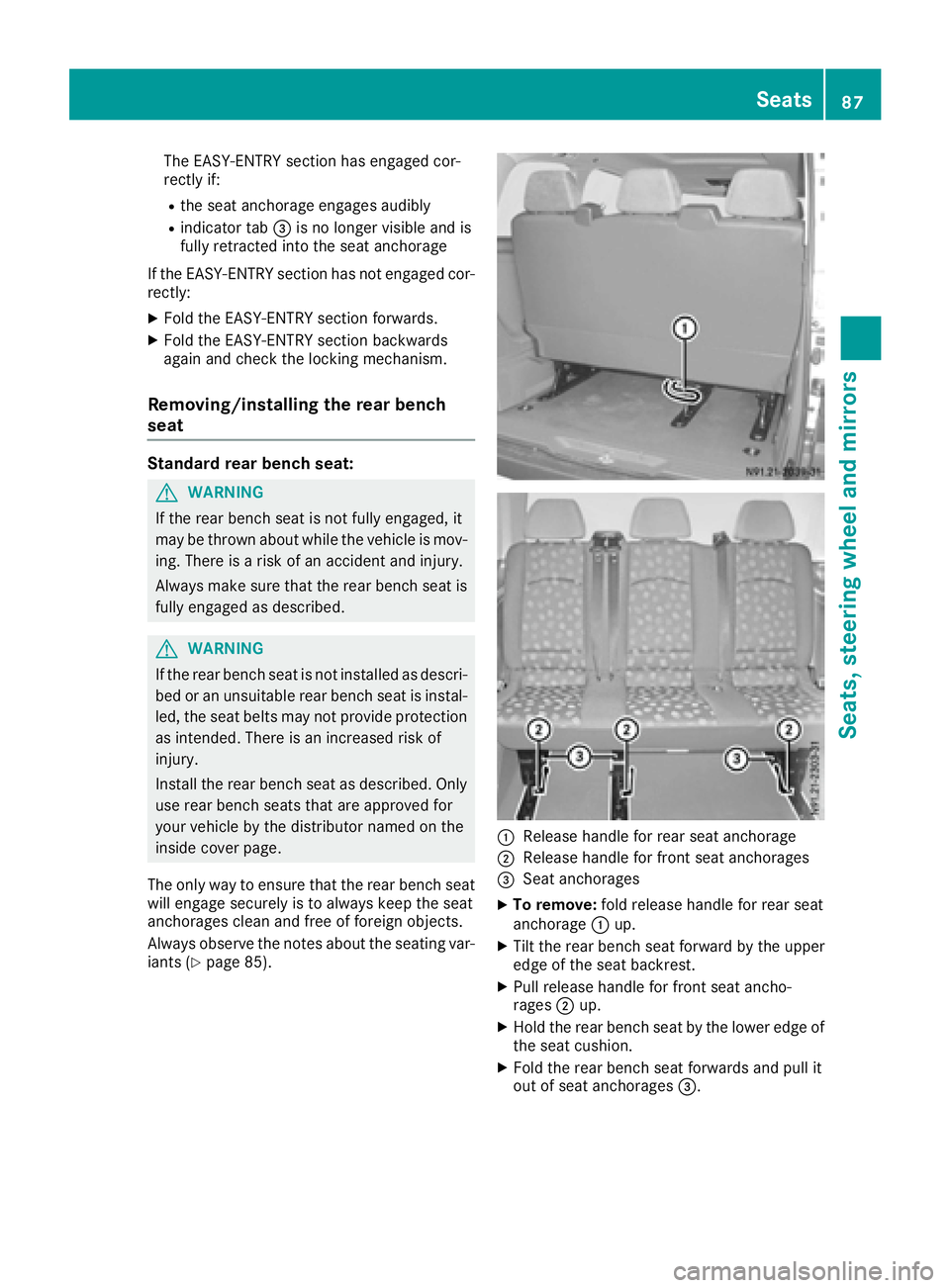
The EASY-ENTRY section has engaged cor-
rectly if:
Rthe seat anchorage engages audibly
Rindicator tab=is no longer visible and is
fully retracted into the seat anchorage
If the EASY-ENTRY section has not engaged cor-
rectly:
XFold the EASY-ENTRY section forwards.
XFold the EASY-ENTRY section backwards
again and check the lockingm echanism.
Removing/installing the rear bench
seat
Standard rear bench seat:
GWARNING
If the rear bench seat is not fully engaged, it
may be thrown about while the vehicle is mov-
ing. There is arisk of an accident and injury.
Always make sure that the rear bench seat is
fully engaged as described.
GWARNING
If the rear bench seat is not installed as descri- bed or an unsuitable rear bench seat is instal-
led, the seat belts may not provide protection
as intended. There is an increased risk of
injury.
Install the rear bench seat as described. Only
use rear bench seats that are approved for
your vehicle by the distributor named on the
inside cover page.
The only way to ensure that the rear bench seat
will engage securely is to alwaysk eep the seat
anchorages clean and free of foreign objects.
Always observe the notes about the seating var-
iants (
Ypage 85).
:Release handle for rear seat anchorage
;Release handle for front seat anchorages
=Seat anchorages
XTo remove: fold release handle for rear seat
anchorage :up.
XTilt the rear bench seat forward by the upper
edge of the seat backrest.
XPull release handle for front seat ancho-
rages ;up.
XHold the rear bench seat by the lower edge of
the seat cushion.
XFold the rear bench seat forwards and pull it
out of seat anchorages =.
Seats87
Seats, steering wheel and mirrors
Z
Page 90 of 310
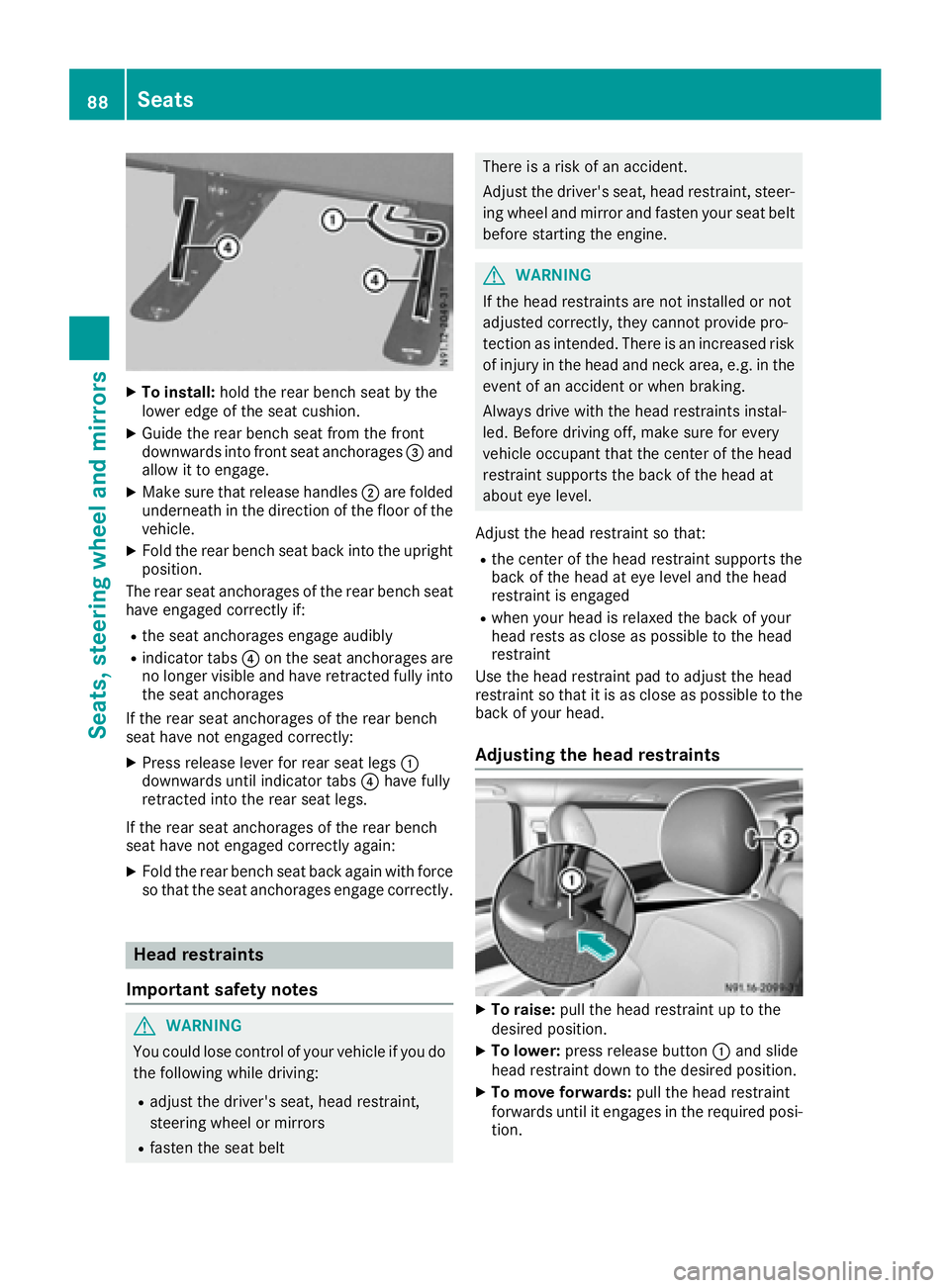
XTo install:holdthe rea rbench sea tbythe
lowe redgeoft he sea tcushion.
XGuid ethe rea rbench sea tfrom the front
downward sinto front sea tanchorages =and
allo wittoe ngage.
XMake sure thatr elease handles;are folded
underneath in the direction of the floor of the
vehicle.
XFol dthe rea rbench sea tbackinto the upright
position.
The rea rseata nchorages of the rea rbench seat
have engaged correctl yif:
Rthe sea tanchorages engage audibly
Rindicator tabs ?on the sea tanchorages are
no longer visible and have retracted fully into
the sea tanchorages
If the rea rseata nchorages of the rea rbench
sea thaven ot engaged correctly:
XPress release lever for rea rseatleg s:
downward suntilindicator tabs ?have fully
retracted into the rea rseatleg s.
If the rea rseata nchorages of the rea rbench
sea thaven ot engaged correctl yagain :
XFoldthe rea rbench sea tbacka gain with force
so thatt he seatanchorages engage correctly.
Hea drestraints
Important safety notes
GWARNING
Yo uc ould lose contro lofyourvehicl eifyoudo
the following whil edriving:
Radjus tthe driver's seat, hea drestraint,
steering whee lormirrors
Rfasten the sea tbelt
There is ariskofana ccident.
Adjust the driver' sseat, hea drestraint, steer-
ing whee land mirror and fasten your sea tbelt
before starting the engine.
GWARNING
If the hea drestraints are not installe dornot
adjusted correctly, they canno tprovid epro-
tection as intended. There is an increased risk
of injury in the hea dand neck area, e.g .inthe
event of an accident or when braking.
Alway sdrive with the hea drestraints instal-
led. Before driving off, make sure for every
vehicl eoccupant thatt he centerofthe head
restraint supports the back of the hea dat
aboute yelevel.
Adjust the hea drestraint so that:
Rthe cente rofthe hea drestraint supports the
back of the hea dateyelevel and the head
restraint is engaged
Rwhen your hea disrelaxe dthe back of your
hea drests as close as possibl etothe head
restraint
Use the hea drestraint pa dtoadjus tthe head
restraint so thatiti sasclose as possibl etothe
back of your head.
Adjustin gthe hea drestraints
XTo raise: pull the hea drestraint up to the
desired position.
XTo lower: press release button :and slide
hea drestraint down to the desired position.
XTo mov eforwards: pull the hea drestraint
forward suntilite ngages in the required posi-
tion.
88Seats
Seats, steering wheel andmirrors
Page 91 of 310
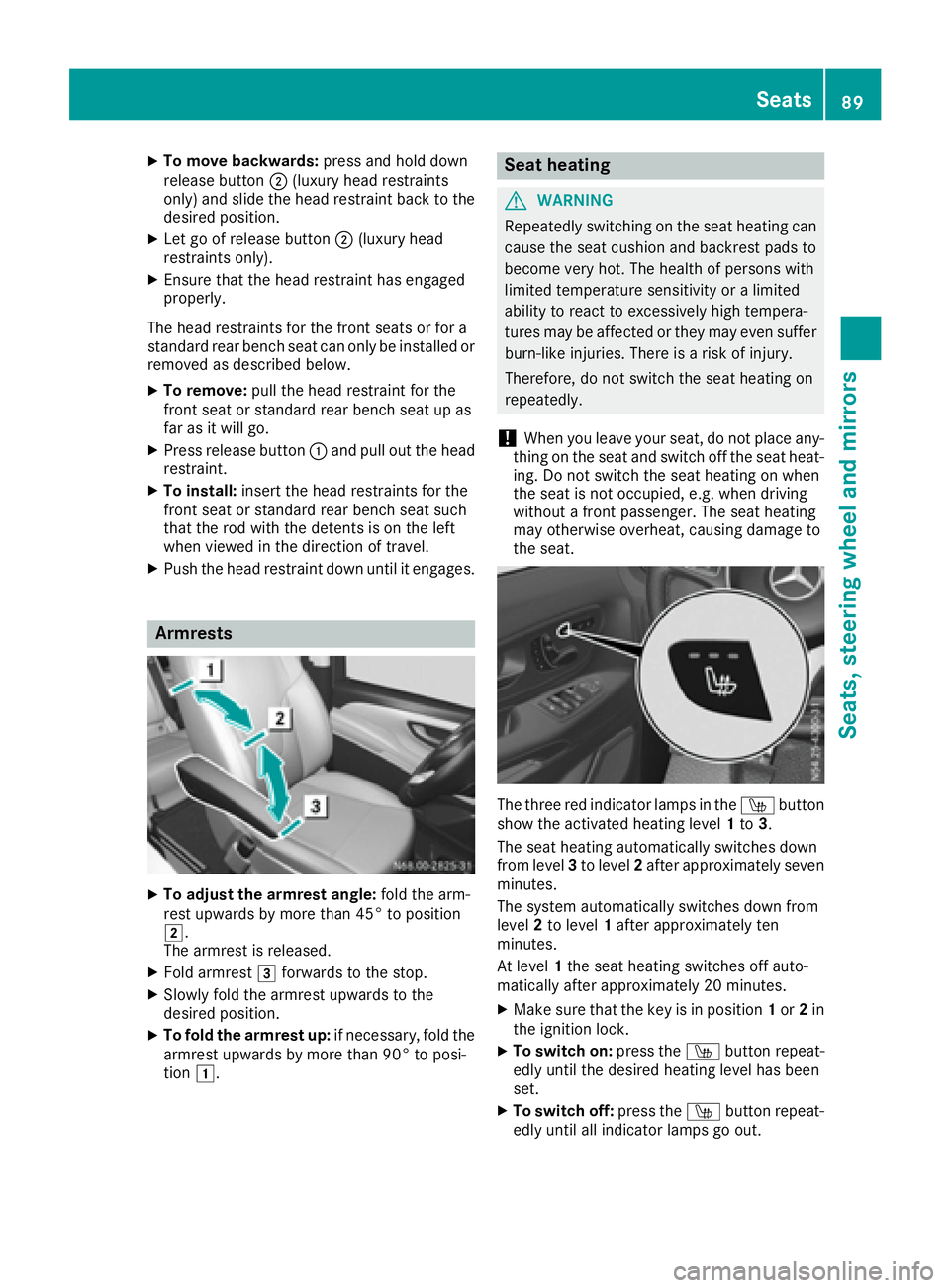
XTo movebackwards: press and hol ddown
release button ;(luxury hea drestraints
only) and slid ethe hea drestraint back to the
desired position.
XLet go of release button ;(luxury head
restraints only).
XEnsure thatt he headrestraint hase ngaged
properly.
The hea drestraints for the front seats or for a
standard rea rben ch sea tcan onlybei nstalledor
remove dasdescribe dbelow .
XTo remove: pull the headrestraint for the
front sea torstandard rea rbench sea tupa s
far as it will go.
XPress release button :and pull outt he head
restraint.
XTo install: insert the hea drestraints for the
front sea torstandard rea rbench sea tsuch
thatt he rod with the detents is on the left
when viewe dinthe direction of travel.
XPush the hea drestraint down unti litengages.
Armrests
XTo adjust the armres tangle: foldt he arm-
res tupwar ds by more than4 5° to position
2.
The armres tisr eleased.
XFol da rmrest 3forward stothe stop.
XSlowl yfoldt he armres tupwar ds to the
desired position.
XTo fol dthe armres tup:if necessary,f oldt he
armres tupwar ds by more than9 0° to posi-
tion 1.
Seat heating
GWARNING
Repeatedl yswitching on the sea theating can
cause the sea tcushion and backres tpadst o
become very hot. The health of persons with
limite dtemperature sensitivity or alim ited
ability to react to excessivel yhight empera-
ture smaybe affecte dorthey maye vens uffer
burn-like injuries. There is ariskofi njury.
Therefore, do not switch the sea theating on
repeatedly.
!Whe nyou leave your seat, do not place any-
thing on the sea tand switch off the sea theat-
ing .Don ot switch the sea theating on when
the sea tisn ot occupied ,e.g.w hend riving
withou tafront passenger .The sea theating
mayo therwise overheat, causing damag eto
the seat.
The thre ered indicator lamps in the Íbutton
sho wthe activate dheating level 1to 3.
The sea theating automaticall yswitches down
from level 3to level 2afte rapp roximatelys even
minutes.
The system automaticall yswitches down from
level 2to level 1afte rapproximatelyt en
minutes.
At level 1the sea theating switches off auto-
maticall yafterapproximately2 0minutes.
XMake sure thatt he key is in position 1or 2in
the ignition lock.
XTo switc hon:press the Íbutton repeat-
edly unti lthe desired heating level hasb een
set.
XTo switc hoff:press the Íbutton repeat-
edly unti lallindicator lamps go out.
Seats89
Seats, steering wheel andmirrors
Z
Page 92 of 310
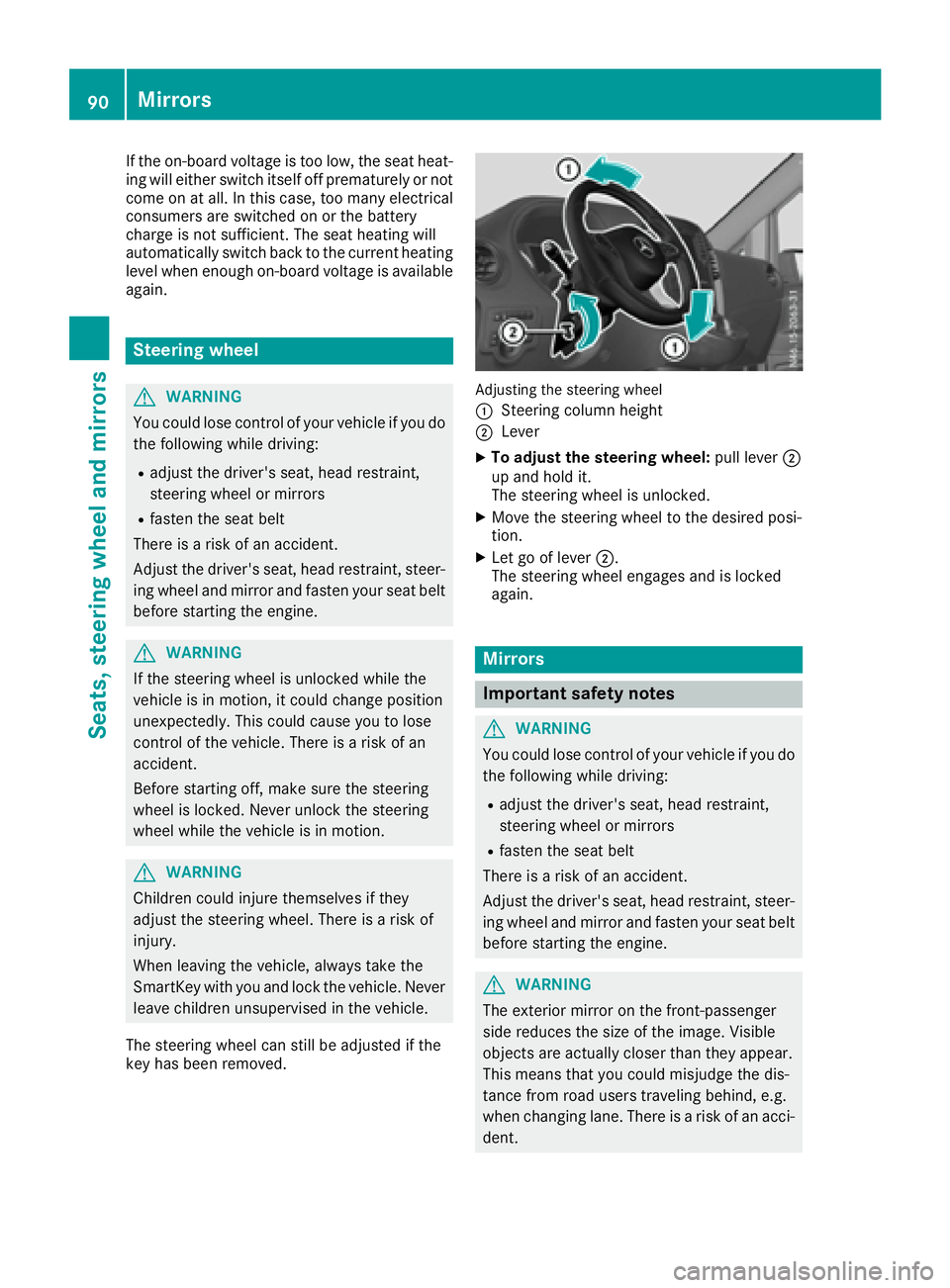
If the on-board voltage is too low, the seat heat-
ing willeither switch itself off prematurely or not
come on at all .Inthis case, too many electrical
consumers are switched on or the battery
charge is not sufficient. The seat heating will
automatically switch back to the current heating
level when enough on-board voltage is available
again.
Steering wheel
GWARNING
You could lose control of you rvehicle if you do
the following whil edriving:
Radjust the driver's seat, head restraint,
steering wheel or mirrors
Rfasten the seat belt
There is arisk of an accident.
Adjust the driver's seat, head restraint, steer-
ing wheel and mirror and fasten you rseat belt
before starting the engine.
GWARNING
If the steering wheel is unlocked whil ethe
vehicle is in motion, it could change position
unexpectedly .This could cause you to lose
control of the vehicle.T here isarisk of an
accident.
Before starting off, make sure the steering
wheel is locked. Never unlock the steering
wheel whil ethe vehicle is in motion.
GWARNING
Children could injure themselves if they
adjust the steering wheel .There is arisk of
injury.
When leaving the vehicle,a lways take the
SmartKey with you and lock the vehicle.N ever
leave childrenu nsupervised in the vehicle.
The steering wheel can still be adjusted if the
key has been removed.
Adjusting the steering wheel
:
Steering column height
;Lever
XTo adjust the steering wheel: pulllever ;
up and hold it.
The steering wheel is unlocked.
XMove the steering wheel to the desiredp osi-
tion.
XLet go of lever ;.
The steering wheel engages and is locked
again.
Mirrors
Important safety notes
GWARNING
You could lose control of you rvehicle if you do
the following whil edriving:
Radjust the driver's seat, head restraint,
steering wheel or mirrors
Rfasten the seat belt
There is arisk of an accident.
Adjust the driver's seat, head restraint, steer-
ing wheel and mirror and fasten you rseat belt
before starting the engine.
GWARNING
The exterior mirror on the front-passenger
side reduces the size of the image .Visible
objects are actually closer than they appear.
This means that you could misjudge the dis-
tance from road users traveling behind, e.g.
when changing lane. There is arisk of an acci-
dent.
90Mirrors
Seats, steerin gwheel and mirrors
Page 93 of 310
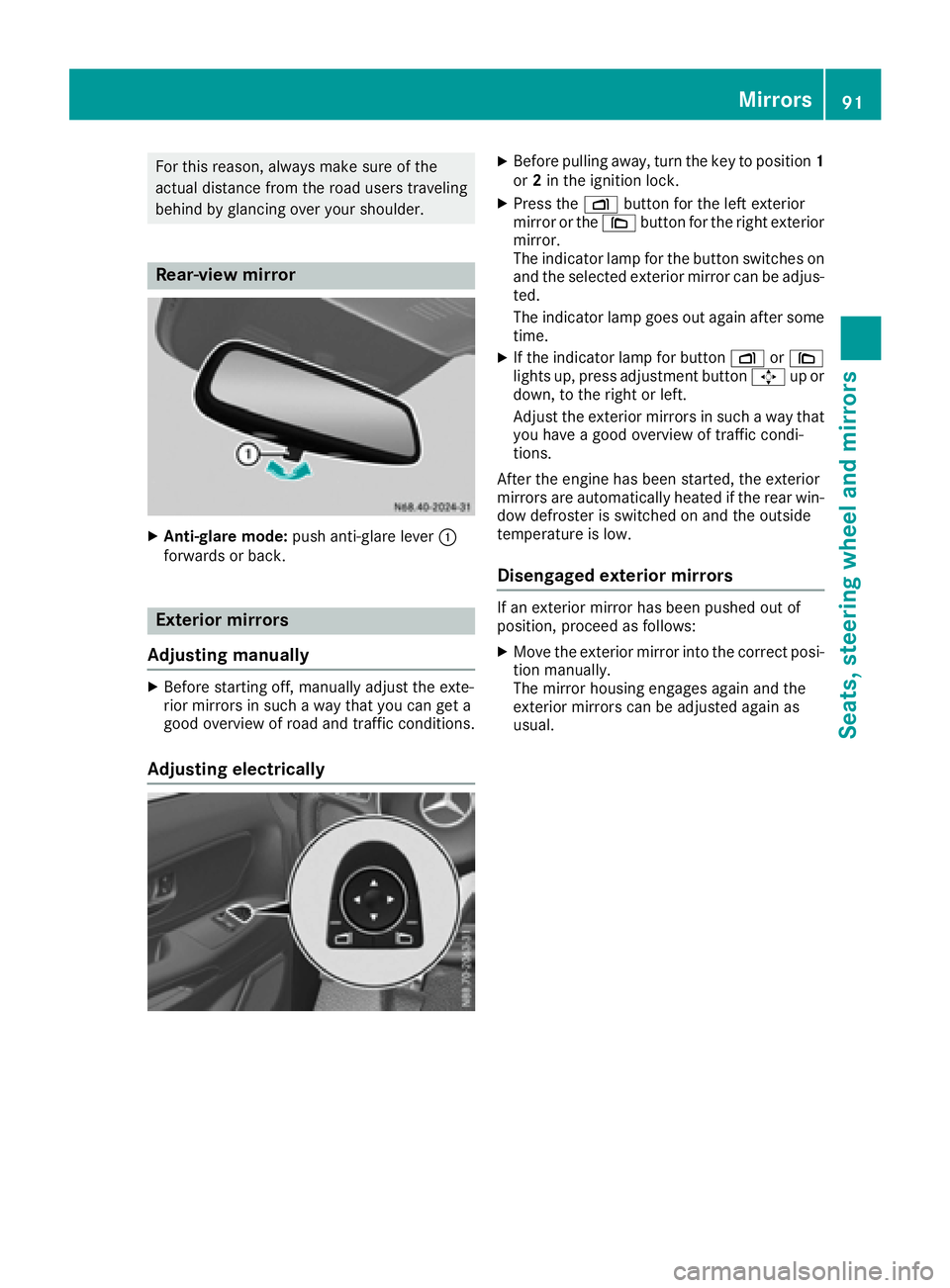
For this reason, always make sureofthe
actual distance from the roadu sers traveling
behind by glancing over your shoulder.
Rear-view mirror
XAnti-glare mode: push anti-glare lever :
forward sorback.
Exterior mirrors
Adjusting manually
XBefores tarting off, manually adjust the exte-
rio rm irrors in such awaythat yo ucan get a
goodo verviewofroadand traffi cconditions.
Adjusting electrically
XBeforep ulling away ,turn the key to position 1
or 2in the ignition lock.
XPres sthe Z button for the lef texterior
mirro rorthe\ button for the right exterior
mirror.
The indicator lamp for the button switches on
and the selected exterior mirro rcan be adjus-
ted.
The indicator lamp goeso utagai naftersome
time.
XIf the indicator lamp for button Zor\
lights up ,press adjustment button 7up or
down, to the right or left.
Adjus tthe exterior mirrors in such awaythat
yo uh aveag oodo vervie woftrafficcondi-
tions.
After the engine has bee nstarted, the exterior
mirrors are automaticall yheated if the rearw in-
dow defroster is switched on and the outside
temperature is low.
Disengaged exterior mirrors
If an exterior mirro rhas bee npushedo utof
position, proceed as follows:
XMove the exterior mirro rinto the correct posi-
tion manually.
The mirro rhousing engages agai nand the
exterior mirrors can be adjuste dagain as
usual.
Mirrors91
Seats, steering wheel and mirrors
Z
Page 97 of 310
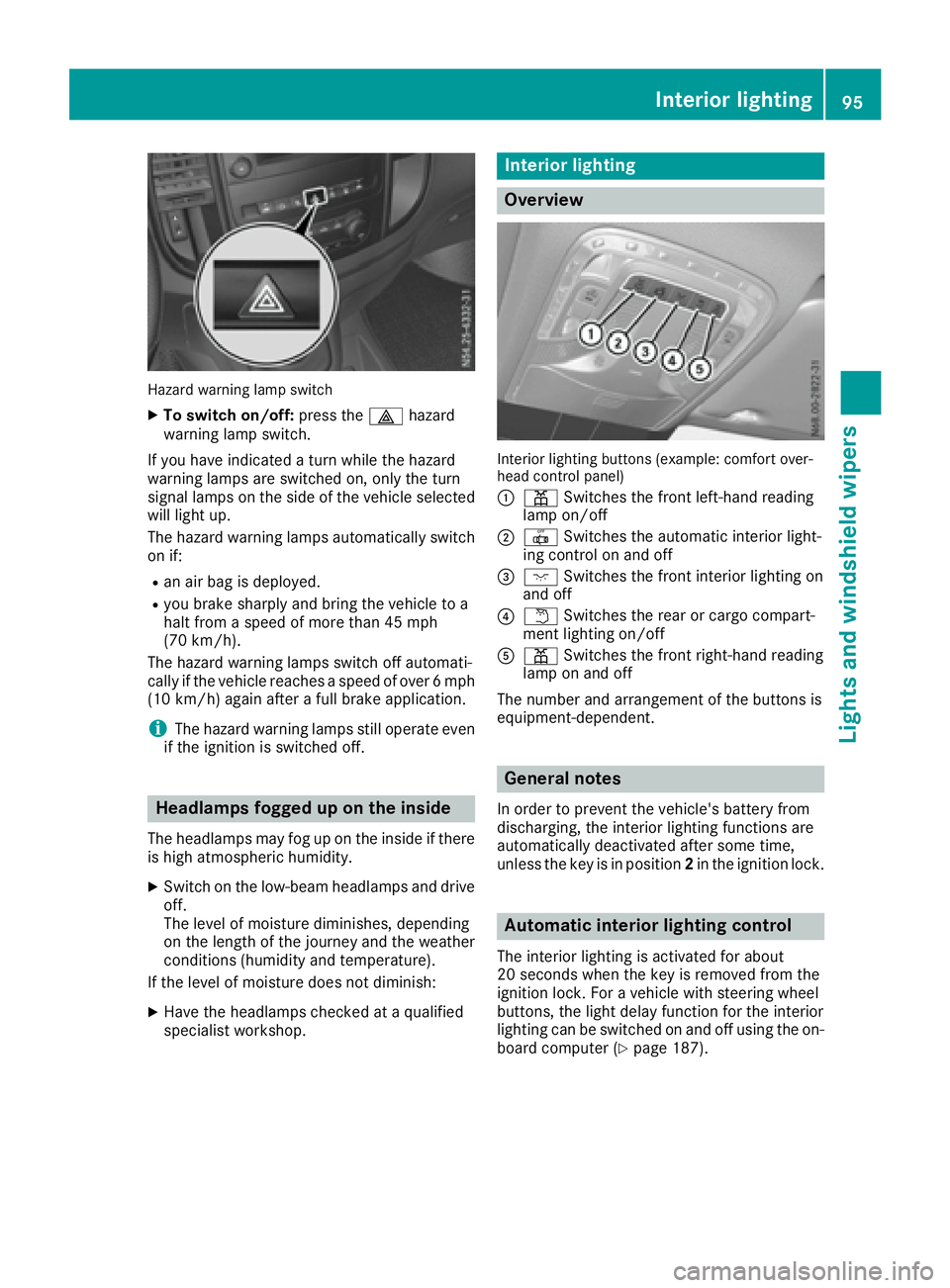
Hazard warning lamp switch
XTo switch on/off:pressthe £ hazard
warning lamp switch.
If yo uhave indicated aturn while the hazard
warning lamps are switched on, only the turn
signal lamps on the sid eofthe vehicle selected
will light up.
The hazard warning lamps automatically switch
on if:
Ran ai rbag is deployed.
Ryoub rake sharpl yand bring the vehicle to a
hal tfrom aspeed of more than 45 mph
(70 km/h).
The hazard warning lamps switch off automati-
cally if the vehicle reaches aspeed of over 6mph
(10 km/h )again after afullb rake application.
iThe hazard warning lamps stil loperate even
if the ignition is switched off.
Headlamps foggedupo nthe inside
The headlamps may fog up on the inside if there
is hig hatmospheric humidity.
XSwitch on the low-beamh eadlamps and drive
off.
The leve lofmoisture diminishes, depending
on the length of the journe yand the weather
conditions (humidity and temperature).
If the leve lofmoisture doesn ot diminish:
XHave the headlamps checked at aqualified
specialist workshop.
Interio rlighting
Overview
Interio rlighting buttons (example: comfort over-
hea dcontrol panel)
:
p Switche sthe front left-hand reading
lamp on/off
;| Switche sthe automati cinterior light-
ing control on and off
=c Switche sthe front interior lighting on
and off
?w Switche sthe rearorc argo compart-
ment lighting on/off
Ap Switche sthe front right-hand reading
lamp on and off
The number and arrangement of the buttons is
equipment-dependent.
General notes
In ordertop revent the vehicle' sbattery from
discharging, the interior lighting functions are
automatically deactivate dafter some time,
unless the key is in position 2in the ignition lock.
Automatic interior lighting control
The interior lighting is activated for about
20 secondsw hent he key is remove dfromt he
ignition lock. For avehicl ewiths teering wheel
buttons, the light dela yfun ctio nfor the interior
lighting can be switched on and off using the on-
boar dcompute r(
Ypage 187).
Interior lighting95
Lights and windshield wiper s
Z